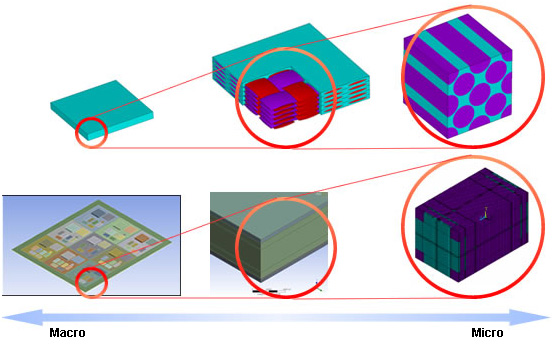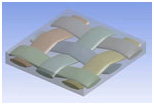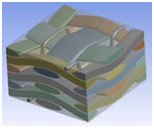![]()
What is Multiscale Analysis?
The multi-scale analysis is literally the means of the analysis that will combine the behavior or the properties of both structure bodies with different scales. To put into a few words, there are various methods to approach and one of the techniques such as the homogenization method has been well known as a typical method. For example, composite materials that are used for various products in recent years consist of multiple, various materials. Supposing that the characteristics of the composite material can be homogenized, we could predict the behavior of the overall product. As a result, ideal material design is possible.

The need for multi-scale analysis
In recent years, a composite material that has anisotropic properties and complex microstructure is used in various products. Therefore, it is necessary to grasp the material characteristics of microstructure first of all in order to understand the behavior of the overall product.
Usually, it is common to perform the material test in order to determine the material characteristics of the composite material. However, characteristics obtained from this test are actually characteristics of the macro-structure instead of the microstructure. Suppose that there is an analysis tool that could consider the characteristics at the micro-level and the macro-level such as parts model or components with different scales of the analysis model simultaneously, and will enable material design that takes advantage of the characteristics of the material inherent. In addition, there is a possibility that if the material could be on the design variables, product development can be performed with great features that did not exist before.
【 Composite Material Example 】
Laminate sheet, fiber reinforced plastic, carbon, metal matrix composites, bone, reinforced concrete, light metal (such as aluminum, magnesium, titanium), alloys (such as stainless steel), fiber (Natural fiber, synthetic fiber, carbon fiber), ceramics, paper, and synthetic resin.
 Cloth material |
 Stitch material |
Utility of multi-scale analysis
Examples of utility of multi-scale analysis are shown below.
- Development of new composite materials
- Development of FRP
- Study of the cross-sectional shape of the filament
- Study of the angle of the strand
- Study of the matrix material
- Study of the crystal orientation
- Product design using composite materials
- Design of Printed circuit board
- Design of bumper
- Study for product defects in composite materials
- Study for product parts with damaged mechanisms
- Alternative to material testing
- production costs reduction of material testing
- Ideal material test
- Reduction of analysis scale
- Simplification of the model using homogeneous material
